What is special about Halikarnassos? To Strabo, a learned geographer at the time of Augustus, the first assets that came to mind were The Tomb of Maussollos and the Salmakis Fountain (Geography 14.2.16).
Strabo’s choice of the former presents no surprise to a modern reader. The impressive tomb of the Karian dynast Maussollos built in the 4th century BC had already obtained a position in the canon of the Seven Wonders of the World. When the emperor Augustus died his sepulchral monument at Rome was referred to as his mausoleum.
Salmakis is perhaps more of a surprise. Salmakis is the name of a local water nymph and of her fountain. It was also the name of a district in ancient Halikarnassos.
The Inscription
Both the nymph Salmakis and her fountain were known to us not only from Strabo but first and foremost from his contemporaries, Ovid (Metamorphoses 4.285-388) and Vitruvius (On Architecture 2.7.11-12). Vitruvius even gave an idea of the location of the fountain. But it was not until 1995 that Vitruvius’ indications by chance were confirmed, when the Turkish authorities discovered a sixty lines long, partially damaged but mainly well preserved, inscription cut into an ancient wall still in situ at the promontory Kaplán Kalessí, also called Salmakis.
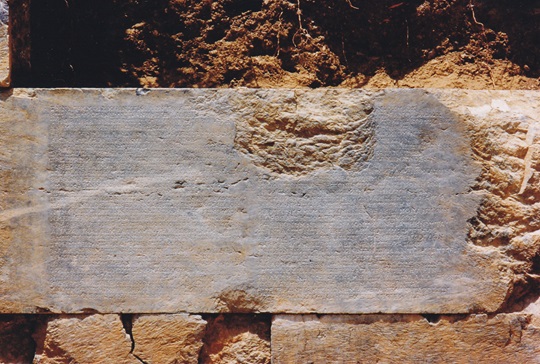
The Bodrum Museum of Underwater Archaeology undertook a preliminary examination of the site in collaboration with the Danish team to which the task to publish the inscription was kindly entrusted.
The layout and the letters of the inscription are exquisite.
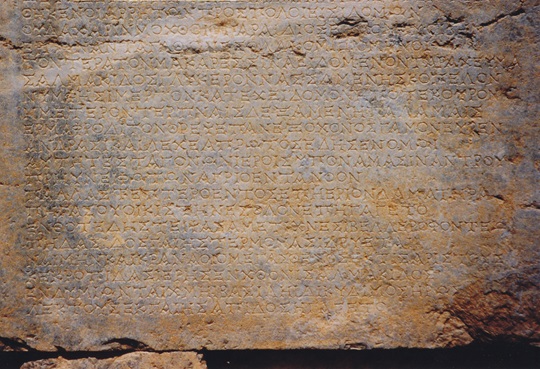
The inscription was clearly meant to serve as a decoration of the room. It was a poem in elegiac verse. The first lines form the poet’s/performer’s invocation of the goddess Aphrodite. She is kindly asked to tell the ignorant what Halikarnassos has to be proud of. Why is the city so beloved by the gods? Her answer takes up the rest of the poem. Early in Aphrodite’s story we encounter her son by Hermes, Hermaphroditos, as well as the water nymph Salmakis, soothing the savage mind of men in her cave with the waters of the her fountain. We hear of several phases of immigration from prominent parts of the Greek world.
The inscription also contains a list of famous authors born in Halikarnassos. First on the list we meet Herodotos, the Father of History or – as the poem has it – “the Homer of history in prose."
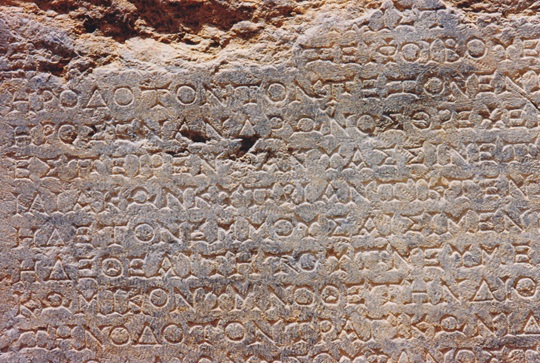
The general theme of the poem is one of civilization. It is the cultural manifest of a Hellenistic city seeing itself as the exceptional and god-blessed fruit of Karian, Dorian, and Ionian seed.
For the editio princeps see
http://www.uni-koeln.de/phil-fak/ifa/zpe/downloads/1998/123pdf/123001.pdf
The Architectural Remains
The Salmakis-Inscription was found in situ carefully cut in a wall and placed at a height inviting the visitor to read it. Albeit no systematic archaeological excavations have taken place at the site it is clear that the wall in case forms part of a larger building complex. The Danish team was allowed to make some measuring and drawing, and an interpretation of these preliminary investigations was published by Poul Pedersen and Birte Poulsen in 2004.
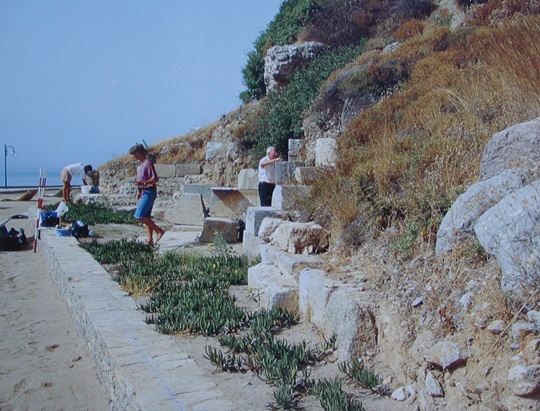
The complex is divided in three A, B, and C:
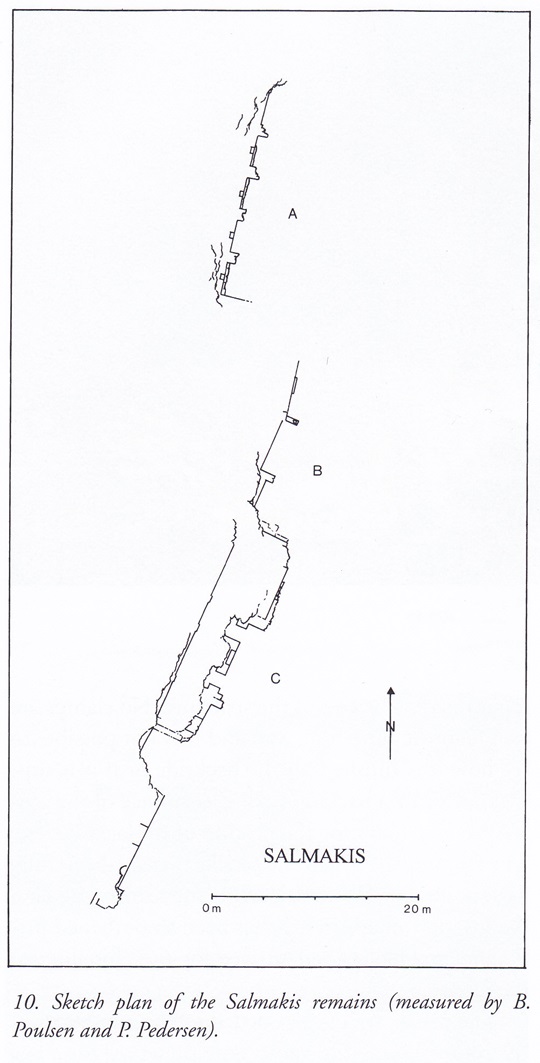
and the inscription sits in the back wall of room III in the central part of the building, part B:
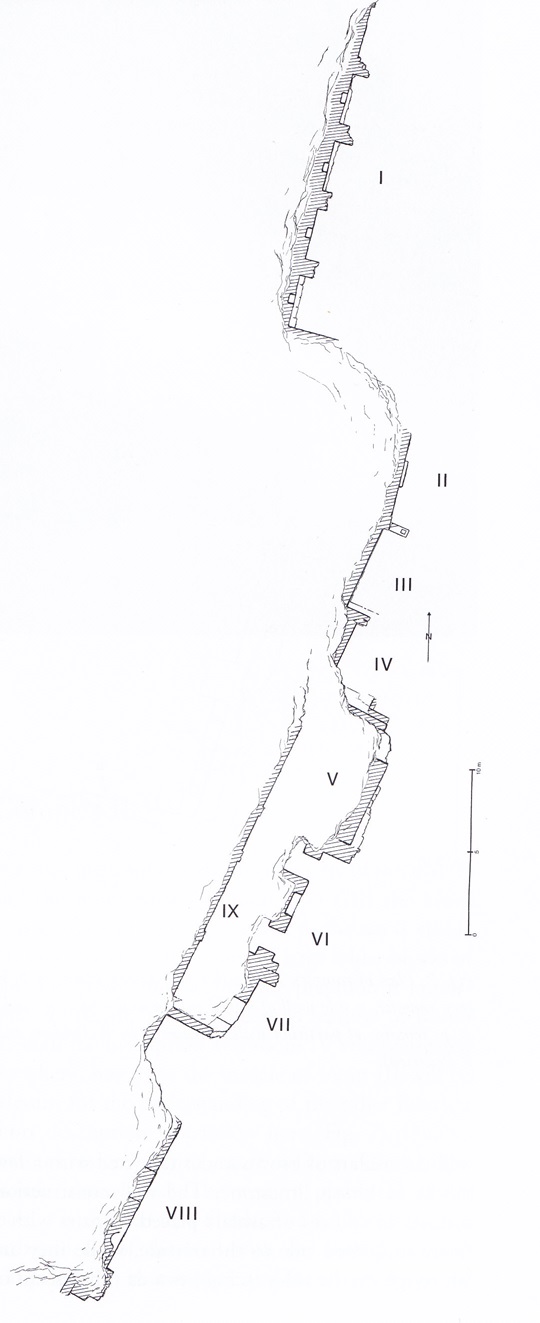
This part of the building is Hellenistic and part A is probably its contemporary, while part C is an enlargement, probably from the 1st or 2nd century AD. Part C was furnished with mosaic floors and at the same time the flooring of room III in part B was renewed with similar mosaics. The room neighbouring the room with the inscription has an entrance to a cave and it is very likely that this contained the Salmakis Fountain proper.
The whole complex was probably attached to – or it formed part of - the sanctuary for Aphrodite and Hermes attested by Vitruvius. Part A was probably a stoa, possibly for dining and – not least – for tasting the soothing waters of the Salmakis Fountain.
An international seminar on the Salmakis Inscription and Hellenistic Halikarnassos was held in Bodrum in a collaboration between Bodrum Museum of Underwater Archaeology, The Danish Institute at Athens, and The University of Southern Denmark. The seminar and the ensuing proceedings were financially supported by The Novo Nordisk Foundation, The Danish Research Council for the Humanities, N.M. Knudsen’s Foundation, and Landsdommer V. Gieses Legat. The literature on the Salmakis Inscription is growing steadily (see below).
The Salmakis Inscription
Signe Isager


We add a Danish translation:
Salmakis indskriften
oversat fra græske vers til dansk prosa
af Signe Isager
"Fortæl mig, Schoinitis, du bærer af et herligt beroligende middel,
Kypris, som hidbringer de myrrhaduftende ....
hvad er det ærefulde ved Halikarnassos?
Jeg for min part har ikke hørt om det - Hvad er det, hun stolt bryster sig af?"
5 "Hun frembragte en stolt høst af jordfødte mænd,
den herlige Zeus Akraios' hjælpere..
Det var dem, der først anbragte den nyfødte Zeus,
barn af Rhea, i skjul under den hule klippekam og opfostrede ham
i Jordens inderste, dengang den lumske Kronos
10 kom for sent til at drukne ham i sit svælg.
Men fader Zeus gjorde de jordfødte til højagtede orgeoner,
som gør tjeneste i den hemmelige bolig.
Og det var ikke utak, de fik til gengæld for deres besvær.
Nej, de fik gode ting for deres gode handlinger:
15 Halikarnassos bebyggede forbjerget, der besynges som elsket af guderne
ved Salmakis liflige (kilde)vand
og omfatter således nymfens indtagende bolig - den nymfe, som engang
modtog vor dreng Hermafróditos i sine dejlige arme
og opfostrede ham til at blive en enestående mand, der opfandt ægteskabet
20 og som den første bandt ægtesengen ved lov.
Hun selv mildner med hulens hellige dråbestrømme
mænds vilde sind.
Og Pallas hidbragte gennem luften betvingeren af den vingede
Pegasus, en god kolonisator,
25 hvor hun trådte i Bellerofontes' spor
og har fæstnet grænsepælene for det pedasiske land.
Ja, den mægtige Kranaos har faktisk også plantet de bedste Kekropider
i den hellige Salmakis' jord.
Og den navnkundige Endymion ledte
30 med sin kongelige lanse udvalgte mænd fra Apis' land.
-----------------------------------Poseid]ons søn
-----------------------------------Antheader
-------------------------------Radamanthys -- lige---rustet
------------------------------------------anbragte
35 ---------------------------------søn af Foibos
-------------------------------------??
--------------------------------------førte Ariadne
-------------------------------efterlod -- barn
------------------------------fik til at slå rod i det fremmede
40 ----------------------------------udmærkende sig
----------------krans----med hånden-----dorisk
-----------------------------------på Foibos' bud
Hun frembragte Herodot, prosaens Homér inden for historieskrivningen,
gav næring til Androns navnkundige kunst,
45 såede Panyassis, den bemærkelsesværdige mestrer af episk digtning
fødte Kyprias, der digtede Iliaka,
og hun fik Menestheus til at skyde frem, han som er fortrolig med musernes verden.
og barslede med Theaitetos' guddommelige inspiration.
Hun er mor til komediedigteren Dionysios
50 Hun frembragte Zenodotos, den fremragende tragediedigter
og fik digteren Fanostratos, Dionysos' tjener,
der stråler i Kekropidernes hellige kranse,
og skabte Nossos, der angiver tiden i historieskrivningen (kronografen)
Hun blev mor til den kloge digter Timokrates
55 og fødte andre gode mænd som arvtagere efter de gode. Den uendelige fremtid vil
aldrig ophøre med at fortælle om alle beviserne på hendes ry.
Meget herligt har hun gennemført til lands, og meget godt
udretter hun til vands sammen med hellenernes førere.
Hun sidder inde med en suverænt ærefuld hædersgave for sine fromme gerninger, og
60 når det drejer sig om gode gerninger, har hun krav på de ypperste kranse."
Literature on the Salmakis inscription
Austin 1999
C. Austin, Notes on the "Pride of Halicarnassus", ZPE 126, 1999, 92.
Bearzot et alii 2003
C. Bearzot, F. Landucci & G. Zecchini, eds., Gli stati territoriali nel mondo antico. Contributi di storia antica, 1. Milano 2003.
Boedeker 2002
D. Boedeker, Epic heritage and mythical patterns in Herodotus, in Egbert J. Bakker, Irene F. de Jong & Hans van Wees, eds., Brill’s Companion to Herodotos, Leiden, Boston, Köln, 2002, 97-116.
Bremmer 2009
Jan N. Bremmer, Zeus’ Own Country: Cult and Mythe in the Pride of Halicarnassus, in Dill & Walde 2009, 292-312.
Brixhe 1999
C. Brixhe, Bulletin Epigraphique, REG 112, no. 490.
Burgess 2002
Jonathan Burgess, Kyprias, the Kypria, and Multiformity, Phoenix 56, 2002, 3-4, 234-245.
Campanile 2003 D. Campanile, L'infanzia della provincia d'Asia: l'origine dei 'conventus iuridici' nella provincia, in Bearzot et alii, eds., 2003, 271-288.
Carstens & Flensted-Jensen 2004
A.M. Carstens, A.M. & P. Flensted-Jensen, Halikarnassos and the Lelegians, in Isager & Pedersen, eds., 2004, 109-123.
D’Alessio 2004
J.B. D’Alessio, Some Notes on the Salmakis Inscription. In Isager & Pedersen, eds., 2004, 45-47.
Dill & Walde 2009 U. Dill & Ch. Walde, eds., 2009, Media, Transformations and Sense-Constructions, Berlin, New York 2009.
Dillery, J., Greek Sacred History, American Journal of Philology 126, 4, 505-526.
Gagné 2006
R. Gagné, What is the Pride of Halicarnassus?, Classical Antiquity 25, 1, 2006, 1-33
Gauthier 1995
P. Gauthier, Bulletin épigraphique, REG 108, 1995, nr. 523.
Gigante 1999
M. Gigante, Il poeta di Salmacide e Filodemo di Gadara, ZPE 126, 1999, 91-92.
Gigante 1999a
M. Gigante, Il nuovo testo epigrafico di Alicarnasso, Atene e Roma 44, 1999, 1-8.
Higbie 2003
C. Higbie, The Lindian Chronicle and the Greek Creation of their Past. Oxford 2003.
Isager 1997
S. Isager, The Pride of Halikarnassos, in XI Congresso Internazionale di Epigrafia Greca e Latina. Roma, 18-24 settembre 1997. Preatti / Preliminary Publication, Roma 1997, 211-219.
Isager 1998
S. Isager, The Pride of Halikarnassos. Editio princeps of an inscription from Salmakis, ZPE 123, 1998, 1-23 (reprint in Isager & Pedersen, eds., 2004, 217-237).
Isager 2004
S. Isager, The Salmakis Inscription. Some reactions to the editio princeps, in Isager & Pedersen, eds., 2004, 9-14.
Isager & Pedersen, eds., 2004
S. Isager & P. Pedersen, eds., The Salmakis Inscription and Hellenistic Halikarnassos, Odense 2004.
Isager 2008
S. Isager, Salmakis indskriften, Sfinx 31, 2008, nr. 1, 4-8.
Jameson 2004
M. Jameson, Troizen and Halikarnassos in the Hellenistic Era, in Isager & Pedersen, eds., 2004, 93-108.
Jensen 2004
M. Skafte Jensen, The Pride of Halikarnassos and Archaic Epic, in Isager & Pedersen, eds., 2004, 85-88.
Jeppesen 2004
Chr. Jeppesen, A propos of the List of Colonizers in the Salmakis Inscription: Was Maussollos or his Mythological Namesake referred to in lines 35-36? In Isager & Pedersen, eds., 2004, 89-92.
Lloyd-Jones 1999
H. Lloyd-Jones, The Pride of Halicarnassus, ZPE 124, 1999, 1-14.
Lloyd-Jones 1999a
H. Lloyd-Jones, The Pride of Halicarnassus (ZPE 124 [1999] 1-14): Corrigenda and Addenda, ZPE 127, 1999, 63-65.
Merkelbach & Stauber 1998
R. Merkelbach & J. Stauber, Steinepigramme aus dem griechischen Osten, München-Leipzig 1998, I, 01/12/02.
Merkelbach & Stauber 2004
R. Merkelbach & J. Stauber, Steinepigramme aus dem griechischen Osten V, München-Leipzig 2004, ad Band I, 01/12/02.
Pedersen 1997
P. Pedersen 1997, Investigation and Research in Halikarnassos 1995, in: XIV. Arastirma Sonuclari Toplantisi, I. Cilt 207-217.
Pedersen 2004
P. Pedersen, The Building Remains at the Salmakis Fountain I, in Isager & Pedersen, eds., 2004, 15-30.
Pirenne-Delforge 2011
V. Pirenne-Delforge, La voix d'Aphrodite, le rôle d'Hermaphrodite et la « timè » d'Halicarnasse : quelques remarques sur l'inscription de Salmakis, in Rescendi, F.P & Y. V. Olokhine, eds., avec la collaboration de D.Barbu & Ph.Matthey, 2011, Dans le laboratoire del’historien des religions. Mélanges offerts à Philippe Borgeaud, Genève 2011, 328-344.
Pleket 2001
H.W. Pleket, SEG 48, 2001 no. 1330.
Poulsen 2004
B. Poulsen, The Building Remains at the Salmakis Fountain II. In Isager & Pedersen, eds., 2004, 31-42.
Ragone 2001
G. Ragone, L’Iscrizione di Kaplan Kalesi e la leggenda Afrodisia di Salmakide, in: Studi Ellenistici 13, 2001, ed. B. Virgilio, 75-119.
Robinson 1999
M. Robinson, Salmacis and Hermaphroditus: when two become one (Ovid, Met. 4, 285-388), ClQu 49, 1999, 212-223.
SEG 2001-2008 SEG = Supplementum Epigraphicum Graecum 48, 1998 (2001), no. 1330; 49, 50, 2000 (2003), no. 1104; 52, 2002 (2006), no. 1041; 53-2, 2003 (2007), no. 1197 bis; 54, 2004 (2008), no. 1070.
Santini 2016
M. Santini, A Multi-Ethnic City Shapes Its Past. The "Pride of Halikanassos" and the Memory of Salmakis, ASNP 2016, 8/1, 3-35.
Slings 2002
S.R. Slings, Kleine stad in de grote wereld. Een pas ontdekte poëtische inscriptie uit Halikarnassos, Hermeneus 74, 1 (2002), pp. 2-13.
Sourvinou-Inwood 2004
Ch. Sourvinou-Inwood, Hermaphroditos and Salmakis: The Voice of Halikarnassos. In Isager & Pedersen, eds., 2004, 59-84.
Zecchini 1999
G. Zecchini, Nosso di Alicarnasso, ZPE 128, 1999, 60-62.
Poulsen 2015
B. Poulsen, The mosaics of the Salmakis Fountain in Halikarnassos, in Atti XII Colloquio AIEMA, ed. G. Trovabene, Paris 2015, 367-372.